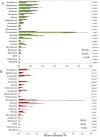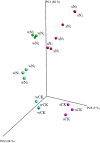Consistent effects of nitrogen fertilization on soil bacterial communities in black soils for two crop seasons in China
- PMID: 28607352
- PMCID: PMC5468298
- DOI: 10.1038/s41598-017-03539-6
Consistent effects of nitrogen fertilization on soil bacterial communities in black soils for two crop seasons in China
Abstract
Long-term use of inorganic nitrogen (N) fertilization has greatly influenced the bacterial community in black soil of northeast China. It is unclear how N affects the bacterial community in two successive crop seasons in the same field for this soil type. We sampled soils from a long-term fertilizer experimental field in Harbin city with three N gradients. We applied sequencing and quantitative PCR targeting at the 16S rRNA gene to examine shifts in bacterial communities and test consistent shifts and driving-factors bacterial responses to elevated N additions. N addition decreased soil pH and bacterial 16S rDNA copy numbers, and increased soil N and crop yield. N addition consistently decreased bacterial diversity and altered bacterial community composition, by increasing the relative abundance of Proteobacteria, and decreasing that of Acidobacteria and Nitrospirae in both seasons. Consistent changes in the abundant classes and genera, and the structure of the bacterial communities across both seasons were observed. Our results suggest that increases in N inputs had consistent effects on the richness, diversity and composition of soil bacterial communities across the crop seasons in two continuous years, and the N addition and the subsequent edaphic changes were important factors in shaping bacterial community structures.
Conflict of interest statement
The authors declare that they have no competing interests.
Figures





Similar articles
-
Application of Bioorganic Fertilizer Significantly Increased Apple Yields and Shaped Bacterial Community Structure in Orchard Soil.Microb Ecol. 2017 Feb;73(2):404-416. doi: 10.1007/s00248-016-0849-y. Epub 2016 Sep 26. Microb Ecol. 2017. PMID: 27670433
-
[Effects of long-term fertilization on bacterial and archaeal diversity and community structure within subtropical red paddy soils].Ying Yong Sheng Tai Xue Bao. 2015 Jun;26(6):1807-13. Ying Yong Sheng Tai Xue Bao. 2015. PMID: 26572036 Chinese.
-
Effect of crop management and sample year on abundance of soil bacterial communities in organic and conventional cropping systems.J Appl Microbiol. 2015 Jul;119(1):208-14. doi: 10.1111/jam.12822. Epub 2015 May 19. J Appl Microbiol. 2015. PMID: 25866080
-
Influence of land use on bacterial and archaeal diversity and community structures in three natural ecosystems and one agricultural soil.Arch Microbiol. 2017 Jul;199(5):711-721. doi: 10.1007/s00203-017-1347-4. Epub 2017 Feb 23. Arch Microbiol. 2017. PMID: 28233042
-
Consistent effects of nitrogen fertilization on soil bacterial communities in contrasting systems.Ecology. 2010 Dec;91(12):3463-70; discussion 3503-14. doi: 10.1890/10-0426.1. Ecology. 2010. PMID: 21302816
Cited by
-
Medicago truncatula root developmental changes by growth-promoting microbes isolated from Fabaceae, growing on organic farms, involve cell cycle changes and WOX5 gene expression.Planta. 2019 Nov 29;251(1):25. doi: 10.1007/s00425-019-03300-5. Planta. 2019. PMID: 31784832
-
The Application of Mixed Organic and Inorganic Fertilizers Drives Soil Nutrient and Bacterial Community Changes in Teak Plantations.Microorganisms. 2022 May 2;10(5):958. doi: 10.3390/microorganisms10050958. Microorganisms. 2022. PMID: 35630402 Free PMC article.
-
Identification of Novel Viruses and Their Microbial Hosts from Soils with Long-Term Nitrogen Fertilization and Cover Cropping Management.mSystems. 2022 Dec 20;7(6):e0057122. doi: 10.1128/msystems.00571-22. Epub 2022 Nov 29. mSystems. 2022. PMID: 36445691 Free PMC article.
-
Decomposing litter and associated microbial activity responses to nitrogen deposition in two subtropical forests containing nitrogen-fixing or non-nitrogen-fixing tree species.Sci Rep. 2018 Aug 28;8(1):12934. doi: 10.1038/s41598-018-30666-5. Sci Rep. 2018. PMID: 30154487 Free PMC article.
-
Chronic fertilization of 37 years alters the phylogenetic structure of soil arbuscular mycorrhizal fungi in Chinese Mollisols.AMB Express. 2018 Apr 17;8(1):57. doi: 10.1186/s13568-018-0587-2. AMB Express. 2018. PMID: 29667106 Free PMC article.
References
-
- Zhou J, et al. Thirty four years of nitrogen fertilization decreases fungal diversity and alters fungal community composition in black soil in northeast China. Soil Biology & Biochemistry. 2016;95:135–143. doi: 10.1016/j.soilbio.2015.12.012. - DOI
-
- Lamarque JF, et al. Assessing future nitrogen deposition and carbon cycle feedback using a multimodel approach. Analysis of nitrogen deposition. 2005;110:2657–2677.
-
- Wang, N. et al. Variability in responses of bacterial communities and nitrogen oxide emission to urea fertilization among various flooded paddy soils. Fems Microbiology Ecology91 (2015). - PubMed
Publication types
MeSH terms
Substances
LinkOut - more resources
Full Text Sources
Other Literature Sources

